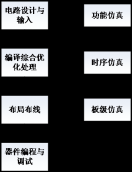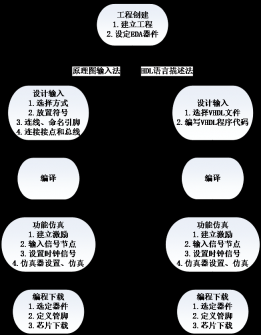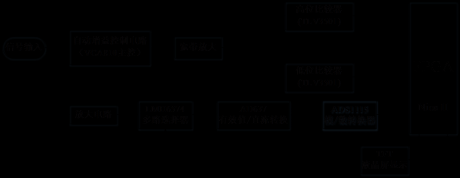论文总字数:27288字
目 录
1 绪论 1
1.1研究目的及意义 1
1.2国内外研究现状 1
1.3 本文主要研究内容 2
2 系统载体FPGA开发介绍 3
2.1 FPGA基本结构及开发语言 3
2.2 FPGA器件分类及编程下载 4
2.3系统开发环境简介 4
2.3.1 QuartusII软件简介 4
2.3.2 NiosII IDE软件简介 5
2.4本章小结 5
3 等精度脉冲参数测量原理 5
3.1脉冲信号及参数定义 5
3.2脉冲参数测量系统结构框图 6
3.3频率测量方法 7
3.3.1传统测量方法简介 7
3.3.2等精度测频法 7
3.4占空比测量方法 9
3.4.1传统测量方法简介 9
3.4.2等精度测量法 9
3.5上升时间测量方法 10
3.5.1传统测量方法简介 10
3.5.2等精度测量法 10
3.6脉冲幅度测量方法 11
3.7本章小结 12
4 外围硬件模块及FPGA系统设计 12
4.1系统供电模块设计 12
4.2增益控制模块设计 13
4.2.1模块整体结构框图 13
4.2.2 模块各子电路设计 14
4.3 高速比较电路模块设计 15
4.4脉幅调理模块设计 15
4.5 FPGA内部模块设计 16
4.5.1 FPGA系统顶层原理图 16
4.5.2模块计数器及锁相环设计 17
4.5.3 NiosII软核配置与搭建 20
4.5.4系统软核编程设计 22
4.6本章小结 24
5 系统调试及性能优化 24
5.1本系统中FPGA器件芯片 24
5.2系统调试及结果分析 25
5.3测量方法的优化 26
5.4本章小结 27
6 结论与展望 27
参考文献: 28
致谢 30
基于FPGA的脉冲参数测量仪的设计
苏洋
,China
Abstract:In modern wars, electronic reconnaissance becomes more and more important, and the pulse parameters measurement with fast speed and high precision is its premise and basis, so the design of high speed and high precision pulse parameters measurement instrument is very important in practical applications. This design uses FPGA as the carrier, based on SOPC technology, using the principle of equal precision measurement, in combination of external signal modulate circuits and FPGA with embedded processor, and realizes the high precision measurement of frequency, cycle, amplitude, pulse width, duty ratio and pulse rise time parameters, so it reaches the high-precision system requirements.
The hardware circuits of the system are the signal modulate circuits, which is responsible for amplification and reshaping of the input pulse signals. This design uses a hurricane fourth generation FPGA chip EP4CE15F17C8N as the measuring platform and system control center, programming specific logic codes of counters with VHDL language in Quartus II development environments, writing application programs of soft-core with C language in the Nios II IDE software, and realizes high-speed acquisition to pulse parameters with the high-speed and parallel processing characteristics. Counters are responsible for counting, soft-core Nios II is responsible for controlling signals, calculating and processing data and driving liquid crystal display, the two interact with each other coordinately to achieve a seamless integration of FPGA and the embedded microprocessor, so as to shorten the development cycle, improve system reliability and reduce the costs of development.
This paper introduces the whole process of the design, and lays special stress on introducing principle of the measurement, establishment of the measurement plan, design of the hardware circuits, design of internal logic function modules of FPGA and programming design of the embedded processor, the paper also provides corresponding charts for auxiliary descriptions. In this paper, the measurement results of the system in testing phases are recorded and presented in the form of tabular. The measured data show that the design has high accuracy, low error rate and good stability.
Key words:FPGA; pulse parameters; SOPC; NiosII; equal precision measurement
1 绪论
1.1研究目的及意义
随着现代科技高速发展,在测量脉冲信号时对精度和速度的相关要求也越来越高[1-4]。脉冲信号有着非常广泛的应用,所以设计出一个高精度脉参测量系统十分必要。目前较为常用的测量工具是利用CPLD或FPGA和单片机进行通信,完成控制命令与数据的传输。其中CPLD或FPGA设计数字硬件模块电路和负责计数,而单片机则作为CPU来处理CPLD或FPGA发送过来的数据,并负责系统的信号控制。这种方式的缺点是若频率变高,则精度会大打折扣。此外利用单片机来处理数据对FPGA自身的利用率也不高,因此本系统使用FPGA内部软核NiosII来作为核心处理器。
本系统选择NiosII作为中央处理器,最大程度地提高效率,让系统的大部分设计得以在一块芯片上完成。这样做的意义在于提高了本设计的稳定度,在保证质量的同时,以最高的效率完成所有设计。NiosII软核的使用不仅实现了低成本,而且可以根据具体需要来减少硬件资源,可方便灵活地实现系统设计。本系统选择了等精度测量方案,有效降低了测量误差,提高了测量精度。本设计基于SOPC技术,具有测量精度高、通用性好、稳定性高、成本低、测量参数多、测量信号频率范围广等特点。
1.2国内外研究现状
国内外有很多测量脉冲频率的方法,直接测频法、测周法、游标法、内插法是较为常用的方法。但是这些传统测量方法一般只能在某一段频率内达到高精度测量要求,一旦被测信号频率产生变化,这些方法的测量精度将会受到影响。
直接测频法会记下时间t内所经过的脉冲信号的个数,再算出单位时间的脉冲个数,最终得到被测脉冲频率。虽说这种方法简单,但误差相对较大,精度有待提高。而直接测周法会先测出待测周期T,由 得到待测频率f,但精度也偏低。直接测频法适合测高频信号,而直接测周法适合测量低频信号。但这两种方法均不能同时对高频信号和低频信号进行等精度测量[5]。上述两种方法的测量结果都会存在
得到待测频率f,但精度也偏低。直接测频法适合测高频信号,而直接测周法适合测量低频信号。但这两种方法均不能同时对高频信号和低频信号进行等精度测量[5]。上述两种方法的测量结果都会存在 1个脉冲的误差,这使得它们无法被广泛推广。此外还有一种模拟方法:游标法,该方法精度确实较高,但是付出的代价是需要设计复杂的电路。与游标法一样,内插法也是采用模拟的方法,相应的电路设计也同样很复杂。如上文所述,脉频的测量方法较多,下文将介绍其他脉冲参数的测量方法。
1个脉冲的误差,这使得它们无法被广泛推广。此外还有一种模拟方法:游标法,该方法精度确实较高,但是付出的代价是需要设计复杂的电路。与游标法一样,内插法也是采用模拟的方法,相应的电路设计也同样很复杂。如上文所述,脉频的测量方法较多,下文将介绍其他脉冲参数的测量方法。
林震鹊、姜秋喜、莫翠琼等人对上升时间做出了研究,最终提出了一种“能量等效”算法的测量方法[6]。该方法首先计算出包络能量 ,a(n)表示幅度,再得到
,a(n)表示幅度,再得到 ,并以此计算出等效包络能量
,并以此计算出等效包络能量 。同理假设新的门限电平
。同理假设新的门限电平 所对应的有效计数从m1到m2,那么
所对应的有效计数从m1到m2,那么 ,从而推导出上升时间为
,从而推导出上升时间为 ,其中
,其中 是ADC采样周期。
是ADC采样周期。
剩余内容已隐藏,请支付后下载全文,论文总字数:27288字
相关图片展示:





该课题毕业论文、开题报告、外文翻译、程序设计、图纸设计等资料可联系客服协助查找;


